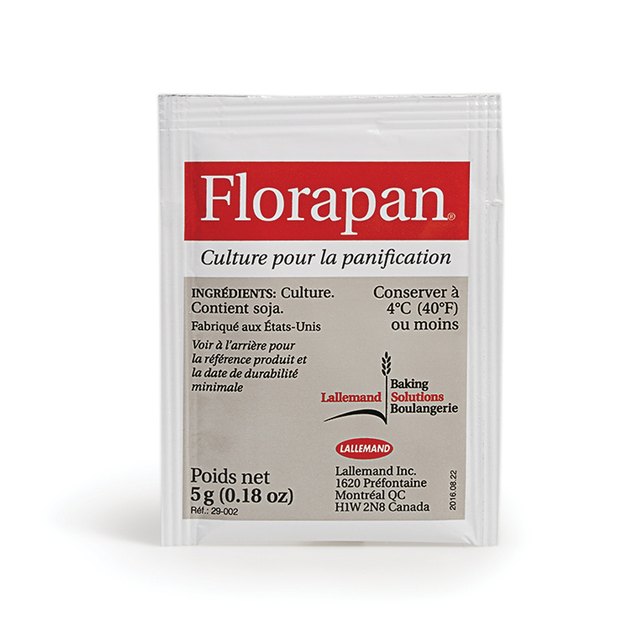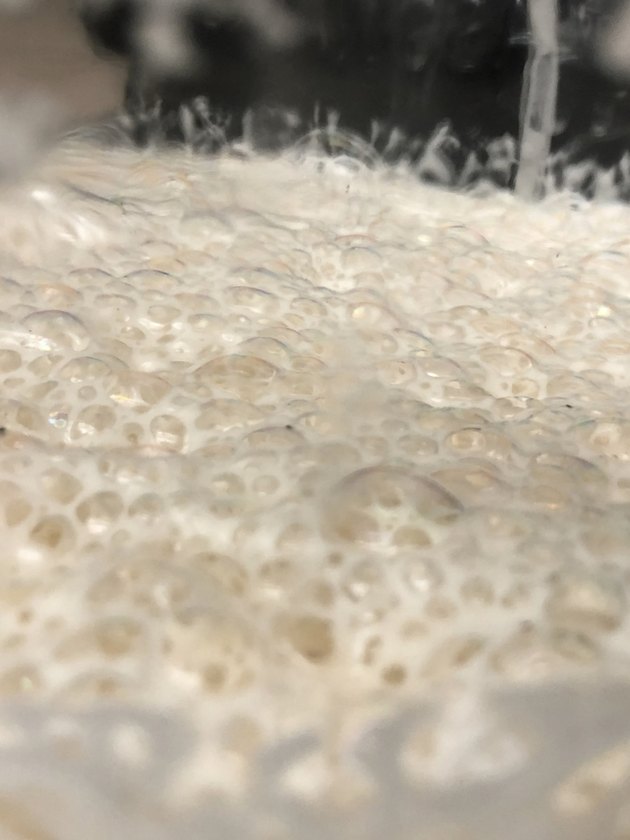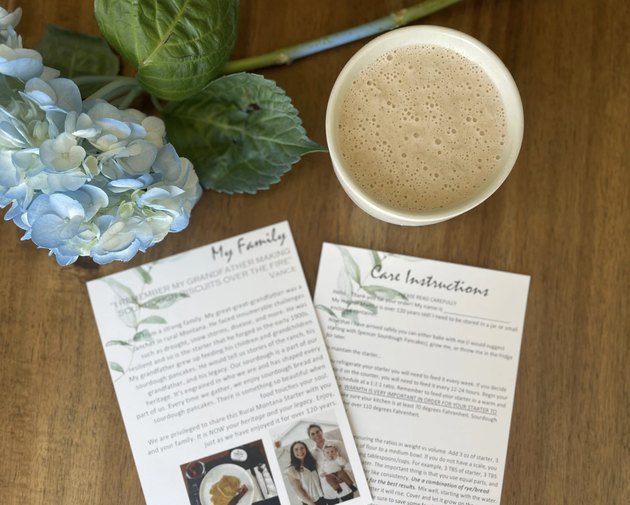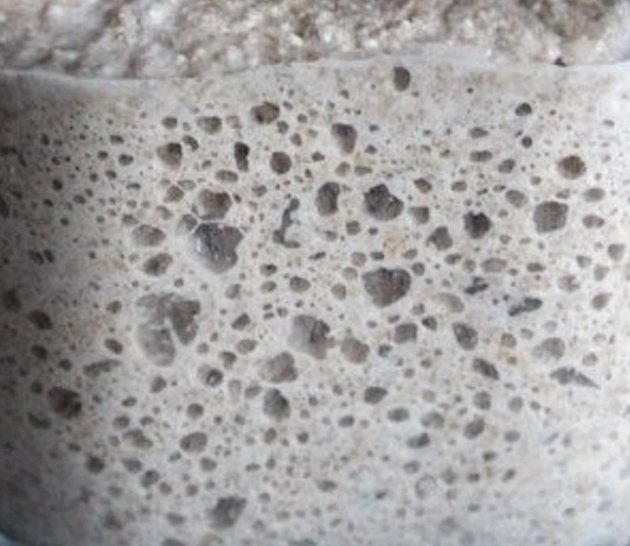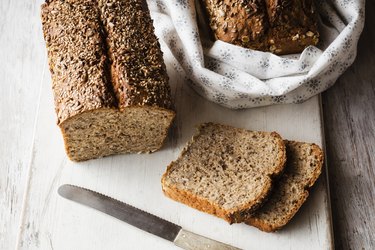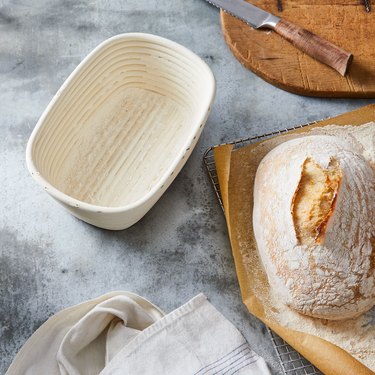
When was the last time you made room for a bit of magic in your life? That's not a rhetorical question, because sourdough bread is one of the closest things to real-world magic that most of us will see. It's the ancestral form of bread: With nothing more than water and flour, and the wild yeasts that live unseen in your region, you can create some of the best loaves you've ever eaten. Of course, like other wild organisms, yeasts are fickle and unpredictable. For novices, it's often easier to skip a step or two by purchasing a sourdough starter that's well-established and has its own distinctive flavors. Let's take a look at some of the tastiest starters you can buy, and how you'll need to use them.
A Sourdough Primer
Video of the Day
Before we discuss specific starters, let's set the stage by describing how sourdough works. First, you'll need flour and water to create an environment for your yeasts to live in. Unbleached all-purpose flour is fine, but you can also use bread flour (which has more of the gluten that makes bread light and fluffy), whole wheat flour or even rye flour. A wet slurry of water and flour provides a sticky surface to capture any passing yeasts, while the flour's natural carbohydrates provide food for them.
Video of the Day
Yeasts aren't the whole story, though. Beneficial bacteria, known as lactic acid bacteria (the same kind that give naturally fermented pickles and sauerkraut their flavor) also colonize the starter. These bacteria give the starter its tang but they also protect against pathogens (unwanted, dangerous bacteria), which can't survive in the acidic environment created by the lactic acid bacteria (LAB for short). Sourdough yeasts do survive this fermentation process, though, and in turn, produce small quantities of ethanol, which kills off rival bacteria that might otherwise compete with the LAB. The yeasts also break down starches in the flour, freeing up sugars that both they and the bacteria can feed on. Everybody wins!
These yeasts and bacteria come from the ambient environment in your neighborhood, from your hands and utensils, and even from the flour itself (this is why you use unbleached flour). Rye flour is especially known for its lively community of beneficial microorganisms, and even a relatively small quantity of rye in a sourdough starter recipe will get it up and running in a hurry. You don't really need to know what's going on "under the hood" in order to make your own sourdough starter and begin baking bread, but it certainly helps. This quick primer just touches on the basics—what you need to know before purchasing a starter—but there are plenty of tutorials out there if you want to try making one from scratch.

What to Consider When Purchasing a Sourdough Starter
Flavor: Sourdough starters span a wide range of flavors, from relatively mild to very tangy (San Francisco sourdough is famously/notoriously at the strong end of the scale). To be sure you're getting a starter you'll enjoy, read the vendor's description closely and, importantly, comments from purchasers who have baked bread with it, and may perceive the flavors differently. Bear in mind that starters from different regions have different flavors and even starters from the same area can vary widely.
Dehydrated Versus Active: Starters can be shipped in dehydrated form or ready-to-use form. Dehydrated starters are shelf-stable for months (it's a great way to create a backup of your own established starter in case of catastrophe), not sensitive to outside conditions, and cheap to mail. A ready-to-use, active starter is more susceptible to heat or cold in shipping, but you can feed it as soon as it arrives (we'll come back to that shortly) and be making bread dough almost immediately, with that first loaf coming out of your oven just a few days after it arrives. There's no right or wrong, it's just a question of how a given vendor chooses to work.
Age of Starter: A sourdough starter is a symbiotic community of yeasts and bacteria, and like any community, it gains complexity over time. That's why many vendors emphasize the age of their own starter, tracing its lineage back through decades (or centuries) of loving care. It won't necessarily be the biggest factor in your decision—a relatively new starter can be complex and flavorful, and a centuries-old one can disappoint—but there's something to be said for helping carry on a centuries-old tradition.

1. French Sourdough Starter
OK, this is kind of a "cheat" since it doesn't create a working starter as such. Instead, it's more of a substitute for commercial yeast, giving you an easy sourdough loaf without fuss. You just add it to a recipe, mix up the bread, and bake. So why suggest it? Well, two reasons. One is that it's a way to be sure you're going to enjoy sourdough bread before you go all in. Second, you can save a portion of your dough and create a starter from that, building your own leaven which will perpetuate the yeast and bacteria strains that come in the packet of starter. It's nice to have options, and this provides an easy point of entry for novice bakers who just want to have a good loaf of bread. The package makes up to eight loaves of bread, or an infinite number if you turn it into a conventional starter.
2. Classic Fresh Sourdough Starter
If you'd rather jump right in with a conventional starter, this more traditional offering from King Arthur Flour provides an excellent gateway into sourdough baking. It's an ounce of fresh, ready-to-use starter that's modestly described as a "decades-old" strain from New England, where the company is located. Because it's a live, active starter, you should choose a shipping option that requires 10 days or less, and feed it for the first time within 24 hours of receiving it. King Arthur's website provides a good beginner's guide to sourdough baking and also offers a number of recipes using the starter. Aside from selling the starter on its own, King Arthur offers it as a bundle with either a traditional stoneware or practical glass crock (glass lets you "eyeball" your starter at a glance) for gifting purposes or for your own use.
3. MomsSanFranSourdough 233-Year-Old San Francisco Sourdough Starter
Tangy, intensely-flavored San Francisco strains are the ultimate sourdough for a lot of aficionados, and no round-up of starters would be complete without at least one. This one, from Etsy vendor MomsSanFranSourdough, has been in the care of the current vendor's family since the 1850s and can be traced all the way back to 1810 in San Francisco. The starter ships in dehydrated form, and includes detailed instructions for rehydrating it and creating your own starter. Your results will vary somewhat, but you should be ready to try your first sourdough bread recipe within a week or less after rehydrating the starter. The vendor has sold tens of thousands of these starter kits and has an established track record of helping beginners get up and running.
4. ThrivingProvisions 1902 Sourdough Starter
The strains of yeast that flourish in a given area depend, in part, on growing conditions in that area. If you live somewhere that's well above sea level, you may find that you get up and running faster by choosing a starter that hails from a place with similar conditions, like this one from Montana. This strain has been in the vendor's family for over a century, and ships as a live culture that's ready to use. Bear in mind that it's 3 ounces of starter, rather than the 1 ounce you'd get from King Arthur, which a) means you'll build up a larger starter more quickly; and b) accounts for the price difference (it also costs more to ship 3 ounces of starter than 1). Like a San Francisco starter, this one has a robust and tangy flavor.
5. SarasotaSourdough Organic Fresh Sourdough Starter
If you're all in on the "know what I'm putting into my body" ethos, you'll want something a bit more specific than an ordinary starter. This one from SarasotaSourdough will fit the bill for even the pickiest of home bakers, with its 1850-vintage strain of sourdough that's fed with unbleached organic flour. It ships as 100 grams (roughly 3.5 ounces) in a Mason jar, so you can get up and running in a hurry (the bigger your initial starter, the sooner you'll have enough to start baking with). You'll be ready to bake in just a few days, and the vendor is responsive if you have questions.
6. SarverFarms 225+ Year-Old French Starter
If you're looking for a historic starter with a milder sourdough flavor, you won't go wrong with this offering from Etsy vendor SarverFarms. Tracing back to a Paris-area bakery around the turn of the 19th century, it'll give you a loaf with a mild flavor while still offering lots of complexity. The starter package shown here contains a full ounce of dried starter, or you can opt for the smaller half-ounce package at a lower price if you prefer (it just means you'll need slightly longer to work up to a full-sized batch of starter).
7. Organic Rye Sourdough Starter
Rye-based starters are known for being "livelier" than wheat-based (meaning they'll leaven more quickly and powerfully), in part because the rye grain itself includes a greater diversity of useful bacteria. This makes them a great choice, even if you're not intending to bake a lot of rye breads. If you feed your starter wheat flour, it'll still work fine, and you'll retain that added biodiversity from the rye. This specific rye-based starter is made with organic rye berries, ground fresh by the vendor, and then dehydrated for shipping. The package contains 32 grams of dehydrated starter, or just over an ounce, so once it's rehydrated you'll be up and running with a full-sized starter within days.

How to Make Sourdough Starter from Your Purchase
Your sourdough starter will typically come with detailed instructions, and of course, there are many thousands of books and tutorials out there, but we'll finish with a quick overview of how to use your starter once you've got it. By all means, do additional reading before you get started. This quick outline is intended primarily to give you an idea of how much "care and feeding" to expect.
Dry Starter: Crumble your dehydrated starter into a measuring cup or mixing bowl, and then—unless directed otherwise by your vendor—add twice that amount, by weight, in lukewarm water (a good kitchen scale really helps with this). If you don't have a scale, that translates to 1/4 cup of water for 1 ounce of starter or 2 tablespoons of water for 1/2 ounce of starter. Let the mixture sit at room temperature in a warm spot for a few hours, stirring occasionally, until the starter is all dissolved. Then add an ounce of unbleached all-purpose flour or bread flour (about 1/4 cup, for the scale-less) to feed your yeasts, cover it, and let it sit in a warm spot until it starts to become bubbly (that'll take 24 hours or so at 85 degrees Fahrenheit, a bit longer at a lower temperature).
Active Starter: With a live starter, you can skip the rehydration step and go straight to feeding your yeasts. The usual rule for live starters is to use one part by weight of starter, one part flour, and one part water (usually abbreviated as 1:1:1). So if you've got an ounce of live starter, you'd use an ounce each of warm water and unbleached flour (again, that's roughly 1/4 cup of flour). Add the water first and stir it in, to loosen the starter, and then add the flour. Mix it well, and let it rise in a warm place until it's bubbly and active. The actual length of time this takes will depend on the temperature, but in general, it should be just a bit quicker than if you'd started with a dried culture.
Once your culture is bubbling and fermenting nicely, transfer it to a glass jar that has some room for it to grow—maybe three times the size you need for the amount of starter, at this point. You'll need to feed it another time or two, each time with an amount of flour and water that's the same (by weight) as the amount of starter. At some point in this process, you'll outgrow the jar you're using, and at that point, it's time to discard half of the starter. Transfer the remaining starter into a fresh, clean jar, feed it once more, and cover it tightly. After you've repeated this step a time or two, your starter is ready to use as directed in recipes.
Additional Tips
- The discarded starter doesn't actually need to be discarded. Once your starter is working nicely, you can use the discard to make waffles, pancakes, pizza crust, or anything else that appeals to you (you'll have a lot of discard over time, so plan on accumulating lots of recipes that use it).
- Most tap water is chlorinated in order to kill microorganisms that might make it unsafe to drink. Since, in this case, you actually want to keep your microorganisms, it's better to use bottled water or filtered water. Alternatively, you can leave your tap water to sit out, uncovered, overnight so the chlorine can evaporate.
- Starter that's kept at room temperature will need to be fed more often—at least daily, and sometimes twice daily—and will have a milder flavor. Starter that's kept in the fridge may only need to be fed once or twice a week, will work more slowly, and will develop a more complex, tangier flavor.
- Whichever starter you order, it will slowly evolve over time as it becomes colonized with the local microorganisms found in your home, your kitchen and even your own hands. In other words, it will slowly become your own personal, unique starter that's unlike anyone else's. Whether you're a novice in the world of homemade sourdough starter or a seasoned expert, that, inarguably, is pretty cool.
